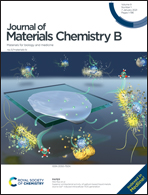Tough thermoplastic hydrogels with re-processability and recyclability for strain sensors†
Abstract
Tough hydrogels with the ability to be repeatedly processed into various shapes as thermoplastics are highly desired in advanced medical devices and tissue engineering. Here, we have developed a kind of versatile supramolecular hydrogel with a network cross-linked by double hydrogen bonds from poly(N-acryloyl glycinamide) (PNAGA). The resulting PNAGA-30 hydrogels (30 wt% solid content) are tough, re-processable, and recyclable similar to thermoplastics. The hydrogels in the form of fragments can be easily re-processed into various shapes including sheet, filament, cylinder and other complex shapes by using simple stamping and injection methods. The mechanical properties of the re-programed hydrogels are comparable to the properties of the original hydrogels. The re-processability and robust mechanical properties of the PNAGA hydrogels are promising for practical applications in soft materials, tissue engineering and wearable devices. Furthermore, the PNAGA-30&LiCl ionic hydrogels can be fabricated by simply compositing LiCl into thermoplastic hydrogels. The PNAGA-30&LiCl hydrogels can function as multifunctional strain sensors to monitor large human movements and tiny vibrations, thereby showing great application potential in robotics, biomedical prosthetics, personal healthcare monitoring and so on.



 Please wait while we load your content...
Please wait while we load your content...